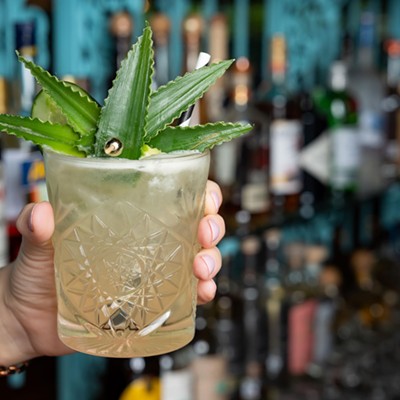As the name would suggest, TQLA is serious about, well, tequila. Bottles of every shape and size glow seductively along red backlit shelving covering much of the rear wall. One-hundred-and-sixty-seven varieties, to be exact, with eight selections on tap, hyper-cooled to five degrees Fahrenheit. "Tequila doesn't freeze," general manager and certified tequilier Scott Lindsay tells us, "but we get it as close to that point as possible. When it comes out it looks like syrup." We can't stomach the diluted, watery result from chilling tequila with a shaker. This guy has the right idea.
We arrived at the Washington Avenue restaurant Wednesday for "More Than Margaritas", the first in a series of hour-long classes and tequila tastings, to be held the first Wednesday of every month. The guest lecturer this evening was Jorge Raptas, an Ambassador for Don Julio, widely considered to be the world's first luxury tequila.
Raptas explained that the four champagne-like glasses at each place setting are actually specifically designed for tasting high-end tequila, and the evening's lecture would cover history, production and how to differentiate between four distinct categories: blanco, reposado, añejo and extra añejo.
Mexican law requires that in order for a spirit to bear the name tequila it must be twice distilled and produced in the states of Jalisco, Nayarit, Michoacán, Guanajuato or Tamaulipas, a region prized for the red volcanic soil best suited to farming the blue agave. Ninety percent of tequila is produced in the state of Jalisco. Los Altos, Jalisco is considered to be the Napa Valley of the tequila world.
On average, agaves must be grown around ten years in order to accumulate the sugars necessary to make tequila. Jimadores remove the thick, spiny leaves of mature agaves, using only the 40-to-70 pound heart in tequila making. The hearts are mashed and cooked at 900 degrees for three days to caramelize the starches. According to Raptas, the caramelized meat of the agave tastes similar to a sweet potato. Yeast is added to aid in fermentation, and the fermented product is distilled once to produce a cloudy liquid known as "ordinario," and then again to produce a crystal-clear silver tequila (a.k.a. blanco or plata). Often the words "100 percent Blue Agave" appear on labels. This refers to the amount of sugar derived from the agave plant in production. Some distilleries add sugar from other sources, the most common being sugar cane.
For the tasting portion of the lesson, Raptas instructed us to first nose the tequila, swirling it in the glass like wine, taste, then taste again for the truest representation of flavor.
Don Julio Blanco Raptas explained that the silver form of tequila is the truest expression of the agave. In theory, if silver is good, all other variations will be as well. Silver tequilas are aged less than two months. The Don Julio Blanca has a grassy smell with a hint of citrus more easily detected on the second swig.
Don Julio Reposado "Reposado" refers to the short period of aging, known as "resting," anywhere from two months to less than a year. Many distilleries age their tequilas in American whisky barrels, contributing to the gradual darkening in color. The Don Julio variety, aged nine months, was noticeably smoother than the Blanco, with has a strong aroma of cinnamon.
Don Julio Añejo To be called "añejo" (or aged), tequila must age between one and three years. Fragrances of butterscotch were instantly apparent in the ultra-smooth añejo from Don Julio, aged 18 months.
Don Julio 1942 A personal favorite, Don Julio 1942 (aged two-and-a-half years) is beyond comparison in terms of smoothness and taste, with heavy notes of vanilla, caramel and toffee. This is no shooting tequila -- it's meant to be sipped and savored (and considering that it's roughly $25 a pop, would you really want to shoot it?)
Extra Añejo The term "extra añejo" is used to describe tequila that has been aged more than three years. Most tequila is not aged beyond this point, due to distinct changes in flavor that are deemed undesirable. That said, Lindsay pointed out a 100-year-old Jose Cuervo on the top shelf of the bar, selling for $450 a shot. When asked how it tastes, both Lindsay and Raptas replied in unison, "Amazing!"
Admission to the monthly "More than Margaritas" classes is free, but space is limited to the first 45 people who reserve a spot by calling the restaurant at 281-501-3237.





